You’ve got your copy of Fire & Knives.
You’ve turned it over in your hands. Admired the neat hand(man)bag size. Fondled the paper. Scanned through quickly. Wondered where to start. Felt a curious warm feeling. Loved the retro design and adverts. Touched the paper (again). Mulled over the contents, undecided whether to read from front to back, dip in randomly, pick the most enticing item first, or save it until last. You’ve held it close to your face; breathed in the wonderful print and paper aroma. Given thanks that the editor and publisher (one Mr T Hayward) had the idea in the first place AND upgraded the paper beyond the bounds of known gsm ratings (did I mention the paper already) to bring you the ultimate in new geeky food writing.

BUT.
Well, its only going to last a certain time. You can devour it voraciously. You can eke it out article by article. You can re-read. But there’s only so long 108 pages can last. And its not the 3 months until the next issue is due.
So what are you going to do in the meantime? You could watch the F-Word. Or various Jamie or Hugh identikit TV programs. Flip through Olive or BBC Good Food or……you could read recipe books and blogs. But I know you’ll feel bereft. Because you’ve found something slightly offbeat, quirky, interesting. You might not have loved every article but they were all good. That’s not to say that other glossier publications, books and TV shows don’t have a place. It’s simply that sometimes you want real far out there food geekery.
Fear not. There are more quirky publications than you might imagine. Here’s some thoughts on things to try whilst you wait for the next issue of Fire & Knives. And a little tale of how one thing leads to another.
It’s all Elizabeth David’s fault….
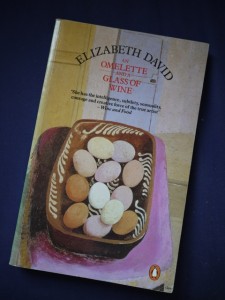
The first vaguely food geeky thing I read was Elizabeth David’s An Omelette and a Glass of Wine. OKAY. I know. Cue eye-rolling all round. Well hang on there. Its not like I’m talking last week. And I know its tedious and a well worn path to cite ED as an inspiration blah blah blah. I didn’t learn to cook from ED; I didn’t learn to love food from ED; I had already learnt plenty of that elsewhere. What I did find was writing that made you wish you’d been there too and writing that added that extra geeky layer of information about food, its history, its provenance. Why did X do this, why was Z traditional and so on. And at the back of the book a reference to a journal dedicated to food studies and food history….
…….Petits Propos Culinaires (PPC)
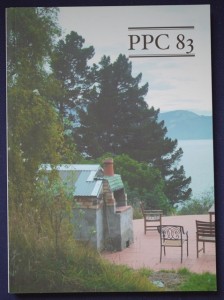
So of course I subscribed, I wanted to know everything there was to know about food. Back then, and I’m only talking the late 80s, there was no blogging, no twitter, no internet community, no easy way to find other people obsessed with food. So I subscribed and I read, avidly, and I still do. PPC is a curious mix of learned border-line academic articles and good stuff written by mates (not my mates, the publishers mates), and a few things you wonder what they are doing in there. And then you realise the same people are also involved in two other off the wall food things….
….firstly….Prospect Books….
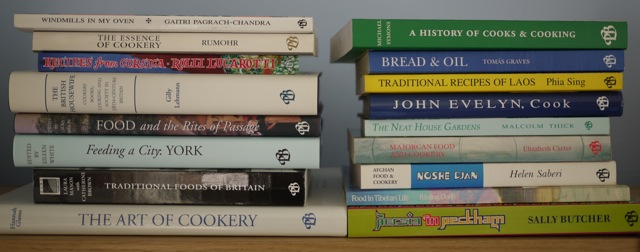
Prospect Books was (and is) the publisher of PPC. But they also publish delightfully quirky and sometimes completely nutty books. Over the years I’ve found treatises on trifle and on marmalade, facsimiles of Hannah Glasse, whole books devoted to the Mallorcan dish pa amb oli (bread and oil), or Afghan food and much more besides. Prospect books was started by the Alan Davidson with his wife. It’s now run by Tom Jaine and it’s as wonderfully quirky as ever.
and then…. the Oxford Symposium on Food & Cookery…..
this is about as fascinatingly quirky and geeky as it comes in the food world. Again inaugurated by Davidson with the likes of ED, Anne Willan and Nicholas Kurti being in there from the beginning, it set out to provide a place for those interested in food to discuss it in a relatively academic way. This is way way way before degrees in Gastronomic Arts started to appear. It was a curious meeting of all those who loved food and had a deep interest in it whatever their background. It wasn’t an academic conference in the sense that anyone could go (the same is true today), you pay your money you get to turn up. Along the way I’ve heard the likes of Margaret Visser, Claudia Roden, Raymond Blanc, Paul Levy, Heston Blumenthal and many others. The food has always been fantastic, how could it not have been. Its sad that H&S regs stopped the ‘bring and share’ lunch but with the likes of Fergus Henderson, Bompas & Parr and Raymond Blanc cooking up a feast this year why would you want to miss out. In my experience its pretty hard to get to present a paper unless you are in the know, but if you are after an uber eclectic experience then this is the place to find it. The papers that are presented are collected and published the following year. They are a mine of information but are not for the faint hearted.
So as I’ve delved deeper and wider into the world of food geekery I’ve come across other things worth reading too. I’ve harboured a desire to really understand and explore all aspects of food and meaning and that’s meant I’ll read everything and anything once and also means I’ve devoted more of my free time than I can count to reading about so many aspects of food. Its lead me to quite academic places, ending up with deciding to do an MA (nearly there on that with just my dissertation to complete very soon). But its been great fun. Here’s some of the other things I’ve found:
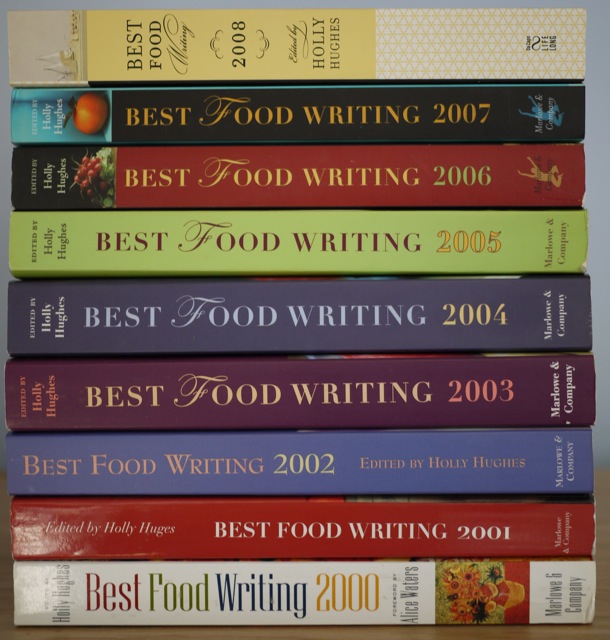
Going to the Oxford Symposium and reading PPC lead me to a lot of the other things on this list, but I spotted this annually published collection on a holiday to the States and I’ve been buying it ever since. Its been another way I’ve found out about good writers and publications. Its been published since 2000 and you can still get all the back copies if you trawl around on Amazon. You’ll find some of the other people I mention here rubbing shoulders with a range of writers from primarily, but not exclusively the US. Its like reading the great writing from lots of magazines and newspapers and tends to send you out on a flurry of subscribing to RSS feeds, adding too many things to your Amazon list and the like. And I believe that the 2009 edition includes an article by the aforementioned Mr T Hayward – I am awaiting delivery of my copy any day now – hey it just arrived whilst I was loading this post ![]()

This is about as home spun as it comes. Its charming and informative. John Thorne knows his stuff and is always keen to investigate the whys and wherefores of recipes, try out knew things and share what he found. Its almost blog like in the way its written, except he’s been doing this since before any of us had the internet, first in print and now in a choice of print of PDF download. Although many of the dishes are American, John eats his way round the world from his home in Massachusetts. To help you catch up there are a number of books of John’s collected writing though for me they don’t have quite the charm of receiving an email saying the next issue is ready to download and then reading from cover to cover (well actually there aren’t any covers but you know what I mean).

Another US production, this time from Edward Behr who is based in Vermont. It ranges from in depth articles on produce to restaurant and book reviews. Its primarily North American and European based in terms of cuisines but the articles and reviews are insightful, thorough and its on very nice paper.
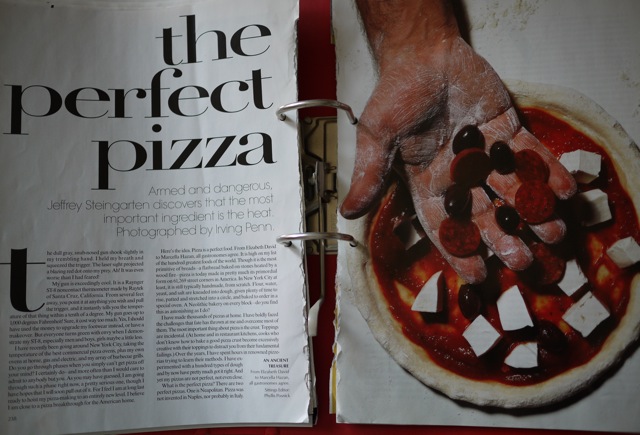
Steingarten has been the food writer at Vogue since 1989 and before his first collection of pieces (The Man who ate Everything) was published in 1997, I used to buy US Vogue just to read him, tearing the pages out to keep and throwing away the rest. He is detailed, obsessive and humorous by turns, bent on finding ways to make wonderful food at home. It’s always amazed me that Vogue was prepared to have his writing sit alongside the fashion and fluff. This is a man who blocks up the vents on his oven in an attempt to get it to proper pizza oven temperature and who talks in graphic detail about the killing of a pig in his quest to make the perfect boudin. Always interesting, always quirky. The man is brilliant. I just wish US Vogue didn’t cost about £5 a month to buy.
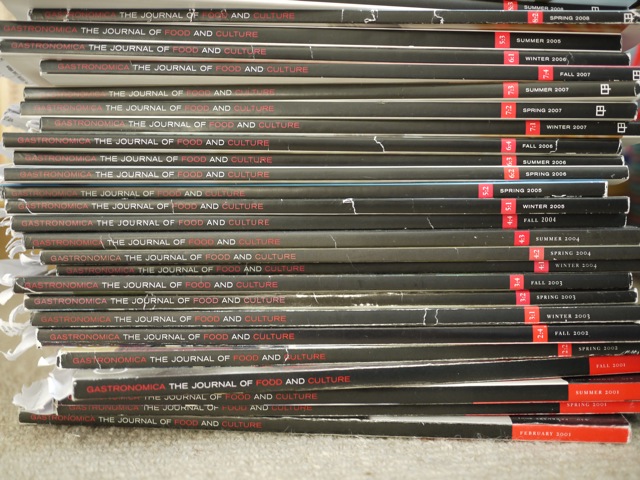
Ok we are getting quite hardcore geeky with this one. Published by the University of California Press this is starting to get fairly academic in style. Mind you its got a good line in glossy paper and provocative covers. It’s a range of social science type articles but I’d mostly say its social science ‘lite’. You don’t have to be a fully paid up anthropologist, sociologist or cultural studies person to be able to get where it’s coming from but it’s not light and fluffy either. The articles aren’t academic papers but I suspect stem from academic research. It covers a lot of ground from offbeat food related art works, old cookery books to traditional foods, issues of food supply and technology and more.
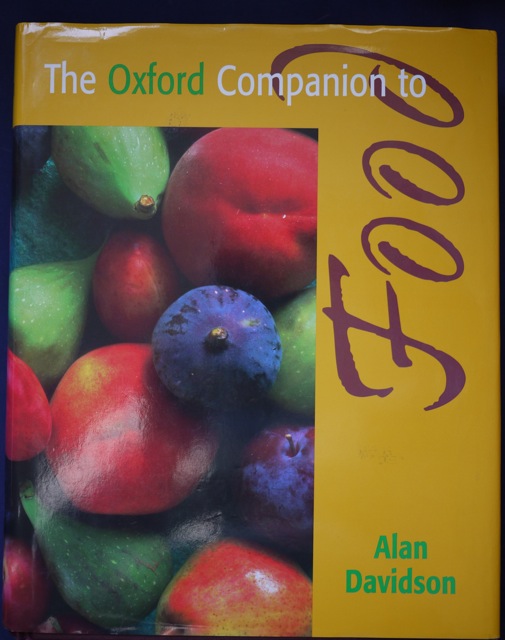
This is Alan Davidson’s magnum opus. It’s a great reference work on so many aspects of food, wonderful for dipping in and out of when you think, “I just wonder where/what/how…”. Its great but there are gaps and that’s part of the appeal, its not as all encompassing as you might like but for me that spurs the imagination to go and find out more from other resources. Of course if you don’t have all of AD’s books on fish then you should get them too, they are fascinating studies by a man who’s day job was as a diplomat and then spent his spare time being passionate about food and becoming esteemed in his own right, finally winning the Erasmus prize in 2003 for his contribution to the birth of Food Studies.

There’s so much I’ve missed off. I could go on and on and on. My bookcases are stuffed full of books about food and I reckon that less than a ¼ are what most people would think of as recipe books. The rest are a combination of reference books, books about a specific ingredient, or region, or country, there’s food history, food science, food culture, out and out academia, pictures and humour. Old books, new books, books for reading cover to cover, books for dipping in and out of. Biographies, magazines, journals, facsimiles, originals, unread and well thumbed. All in all I’m surrounded by in excess of 800 food related books and counting.
So that’s what I’m talking about when I talk about food writing. Go on release you inner geek and try something new this Christmas.




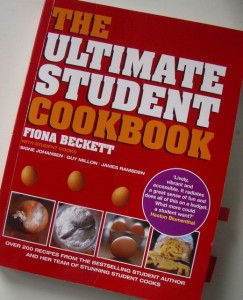
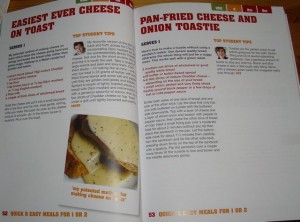
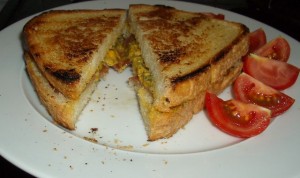
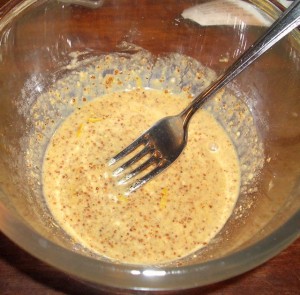


 Hmmm looks like a bunch of weeds in a badly tended garden if you ask me…..but hold one we are going to find at least FOUR, yes that’s four, edible goodies in this patch.
Hmmm looks like a bunch of weeds in a badly tended garden if you ask me…..but hold one we are going to find at least FOUR, yes that’s four, edible goodies in this patch.







